by Wallace Wyss –
1971 Pantera
Any history of DeTomaso has to be “muddled” because unlike the Ferrari or Porsche world the factory itself put out erroneous information, and had no library to speak of. Histories of DeTomaso cars have be be constructed of hearsay evidence.
Here’s what I know….
Allow me to go back in time to 1970. I am invited to a preview in Greenfield Village, a sort of tourist village created by the first Henry Ford so America could remember America before model T Fords were clogging the streets.
I was meeting with a young man named Tom Tjaarda, a soft spoken American, also raised in Detroit who was there to present the car he’d designed in Italy for Ghia, the car called the DeTomaso Pantera.
Now this wasn’t DeTomaso’s first try at a V8 powered mid engine production car. They had started with the Mangusta, designed by a young Giorgetto Giugiaro, but as good as that car looked, it had a lot of mechanical flaws, though Ford rejected it because it took too much hand work to build. They wanted to import a car that could be whacked out in quantity.
So DeTomaso showed them a clay model made by an American, Tom Tjaarda. This was chosen for production instead. Ford liked it because it would be built in a real factory (DeTomaso had bought Vignale) and they liked it because the gearbox was flipped over so it had a few inches more ground clearance (Mangustas would bottom out and crack the gearbox housing).
I remember those first 1971 models. I drove one. It terrified me when the windshield went opaque—something to do with defrosting. And then there was the constant blowing of fuses. But I still snuck it up to 140 mph on the freeway.
The first 75 cars were “push button door” models. And you could say they were more handbuilt than all the other Panteras officially imported into the United States by Ford.
The 1971 Panteras were high performance because they had had high compression at a rating of 330 horsepower. Magazine tests show the 0 to 60 time to be 5.5 seconds with a top speed of 160 MPH. One way to recognize them straight off is the squared off front bumpers.
1972 Pantera
In 1972 the Pantera had modifications beginning with the final 200 cars produced at the end of the 1971 production year. Just a few are:
· 351 Cleveland changed from a 2 bolt main to a 4 bolt main.
· Fans were revised from manual to automatic.
1972 Pantera L
I am presuming L meant luxury. For the second half of 1972 a new bumper law forced DeTomaso to install large black impact bumpers on the front and rear. They looked good but added 200 lbs to the car. Sadly hp output dropped to 248 as a result of a compression to 8.0:1. The following items are the modifications for the Pantera L model:
· 351 Cleveland changed back to a 2-bolt main
· All electrical relays put on a single panel on the left side of the interior; matching fuse panel on the right hand side.
· Revised front-wheel opening flanges to lessen front tires rubbing on inside of fenders.
Over in Yurrip, European Pantera L models did not have the black impact bumpers.
1974 Pantera GTS
In 1974 the Pantera GTS model was introduced, sort of like when Shelby Mustangs were introduced giving Ford a model above the regular Mustang. Hopefully Pantera fans thought it would be higher performance but it was mostly cosmetic. The engine was the same but there was now a Ford 4V Autolite carburetor. Cosmetic changes were:
* All chrome blacked out
* Ferrero steering wheel with Ghia emblem
* GTS wheel logos
* Pop riveted fiberglass fender flairs
* “GTS” script mounted where “Pantera” script was (on the rear)
* “Pantera” script in place of “DeTomaso” script (on the rear)
* Flat black rocker panel stripe widened and “Pantera GTS” written on the stripe
* Gloss black metallic front hood and rear compartment deck
* Ghia emblem on the front bumper (instead of the usual de Tomaso emblem)
* Dash mounted clock installed
* GTS emblem on the gear-shift knob
* Mechanical changes were a more powerful engine with 350 PS (257 kW; 345 hp) DIN at 6000 rpm, thanks to a 11.0 : 1 compression ratio (versus 8.0 : 1 in the US market Pantera), a larger Holley carburetor, a forged aluminum intake manifold, and freer flowing exhaust headers
The GTS mechanical upgrades were a more aggressive steering rack setup, ventilated disc brakes, adjusted spring rates and gear ratios.
Pantera fades out from US
Ford did not want to revise the Pantera to meet new safety and emissions regulations. It was not a good seller. DeTomaso and Ford had fought from the beginning so Ford could hardly wait to see the last of the wily Argentinian. Ford sold about 5500 Panteras in the U.S. from 1971 through 1974.
DeTomaso marches on
Rather oddly, since Ford had paid for its development, when Ford dropped importing the Pantera, they left DeTomaso with ownership of the sales and manufacturing rights for Europe and every area outside of the United States.
So DeTomaso decided to continue on with limited numbers. A couple thousand more were made to 1996.
1975 – 1996 Pantera
Ironically those later ones include some exciting models, including the GT5, with had extra wide rear fenders,the Pantera GT5S and the Pantera 200. A few Pantera shops in the US replicated some of the body panels so hundreds of Panteras on the US market are ’71-74 models with additional parts from the GT5S.
According to Wikipedia,
From May 1980, the lineup included the GT5, which had bonded and riveted-on fiberglass wheel arch extensions and from November 1984 the GT5-S model which had blended arches and a distinctive wide-body look. The GT5 also incorporated better brakes, a more luxurious interior, much larger wheels and tires and the fiberglass body kit also included an air dam and side skirts. Production of the wide body GT5 (and similarly equipped narrow body GTS models) continued until 1985, when the GT5-S replaced the GT5. The Pantera Club of America estimates 197 GT5 Pantera models were built.
The GT5-S featured single piece flared steel fenders instead of the GT5’s bolted-on fiberglass flares, and a smaller steel front air dam. The ‘S’ in the GT5-S name stood for “steel”. Otherwise the GT5-S was largely identical to the GT5. The POCA 9000 series registrar’s VIN analysis indicates that fewer than 183 GT5-S Panteras were built.
The Pantera 90
The Pantera, after Ford dropped importation, became more European. Wikipedia says “In 1990 the 351 engine was replaced by the 5.0-litre Ford 302 engine featuring electronic fuel injection and modified cylinder heads, intake manifolds, camshafts, valves, and pistons. Added were four-wheel ventilated and drilled disc brakes with Brembo calipers that were shared with the Ferrari F40″.
Though the same basic shape was still the one designed by Tjaarda, DeTomaso hired Marcello Gandini to re-do a new body. There was also a rework of the suspension redesign and a partial chassis redesign. The new version L was called the Pantera 90 Si, introduced in 1990.
It is extremely rare, only 41 90 Si were built before the Pantera was finally phased out in 1993 to make way for the radical mid-engined and all European Guarà. Two of the 41 cars weren’t sold– one crash tested and one reserved for the DeTomaso museum (which has since been sold, to who?).
The Targa
Four to five Pantera 90s were sent to coachbuilder Pavesi for conversion to Targas. In my view these are among the most valuable Panteras if Pavesi can be documented as building them. There were aftermarket attempts at making Targas.
The GT/4: The works race cars
Somehow in the list I found on a Pantera website they left off the GT/4. This was a race car. One time I had a list of only 16 made. I saw the pile of thrown away ones at the factory, so I don’t know if they were saved by enthusiasts or their parts (or clones of their parts) retrofitted later on privately owned cars. A few of them raced in Europe and did well, even though Ford gave zero support.
The 7X
At one time I had a dentist in Michigan. I think he mentioned he had a Pantera. I was not inclined to go see it, but realized my mistake decades later in Monterey when I saw it for sale at an auction. It was called the “7X” because at the time it was built it was projected to be a model in the ‘70s but they didn’t yet know what year. I think it sold for close to $100,000 which was dirt cheap for a factory prototype.
In Sum
I have painted portraits of very few DeTomaso cars compared to over fifty Ferraris. Fifty years ago I found DeTomaso owners back then less interested in the Italian part of their car’s history, and not enthusiastic about the marque’s history. But now that has changed. There are now new books on Pantera, and I think when the rarest models start to go for several hundred thousand at auction, there will be aficionados who want to commemorate their passion with an oil on canvas for their den.
Wallace Wyss Art is Shown in the Gallery Below
Information on canvas giclee prints of the works shown is available by writing photojournalistpro2@gmail.com
Let us know what you think in the Comments.
THE AUTHOR Wallace Wyss is a co-host of Autotalk, broadcast on KUCR FM weekly.
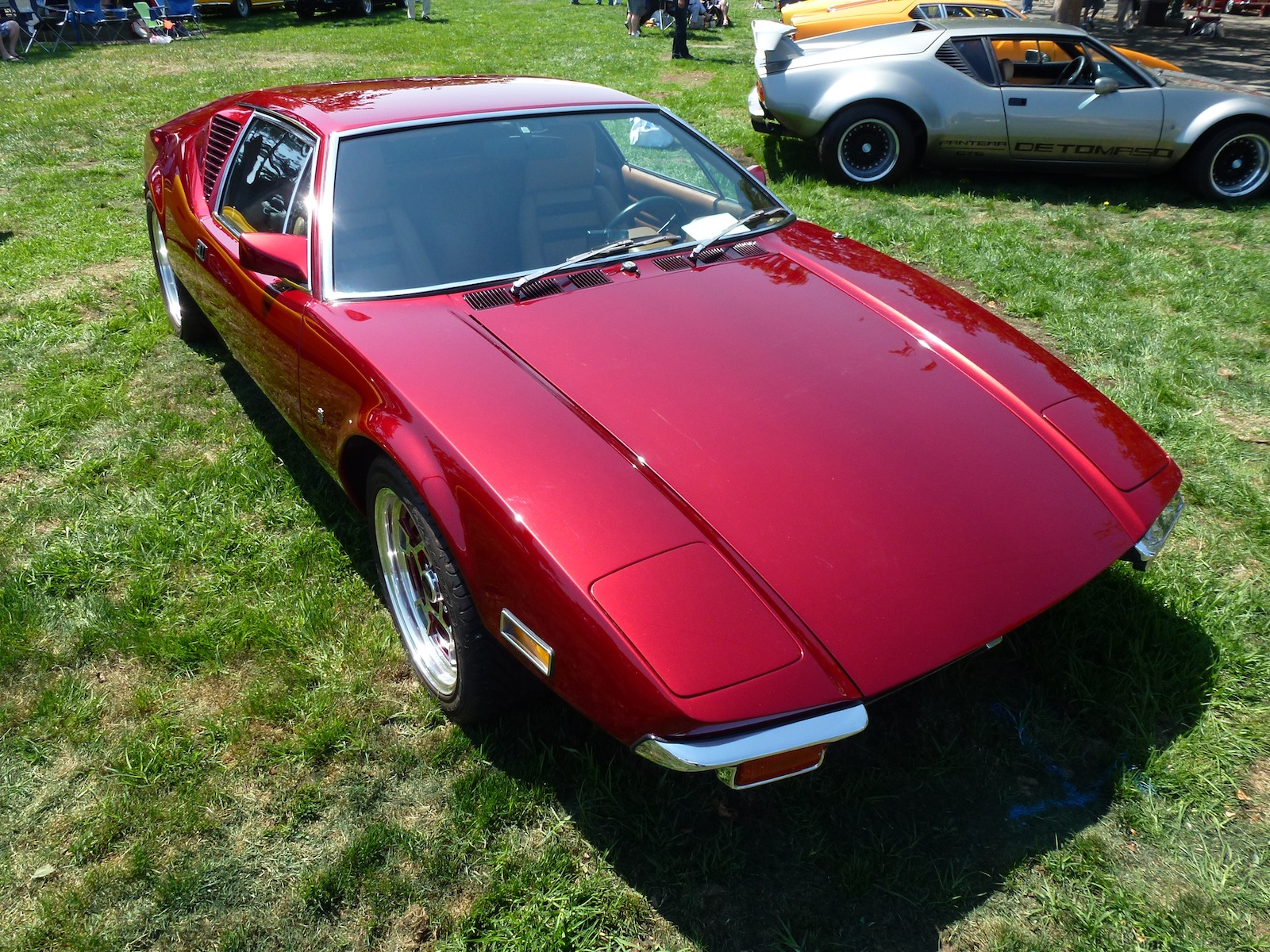
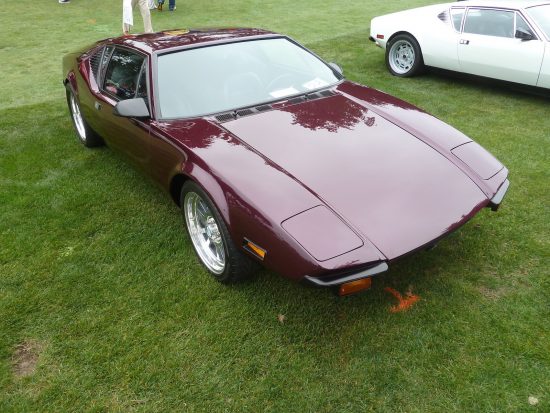

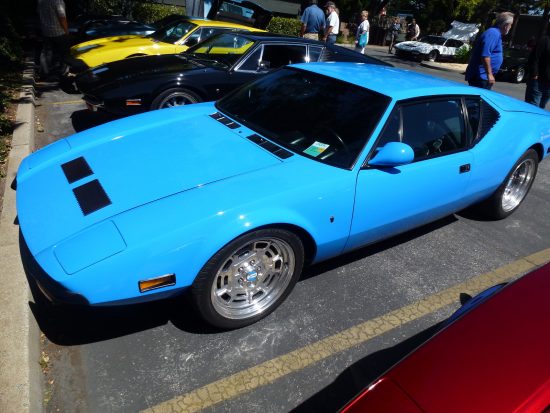
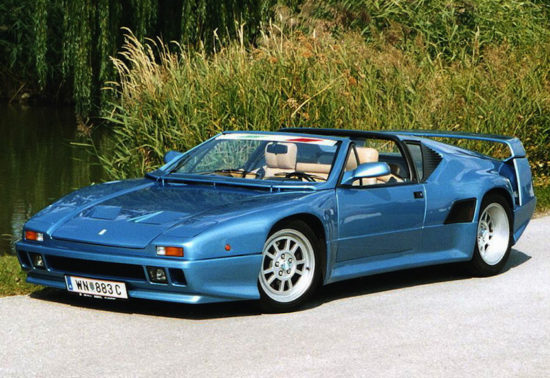














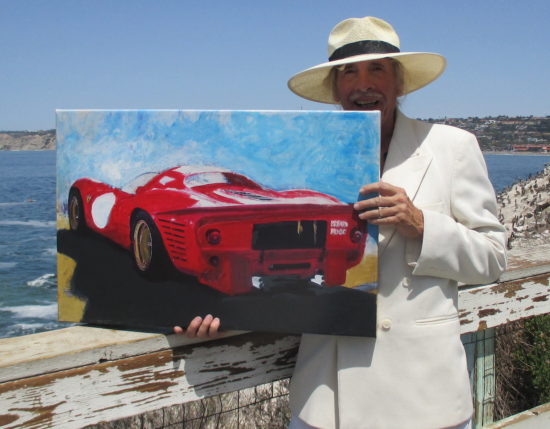
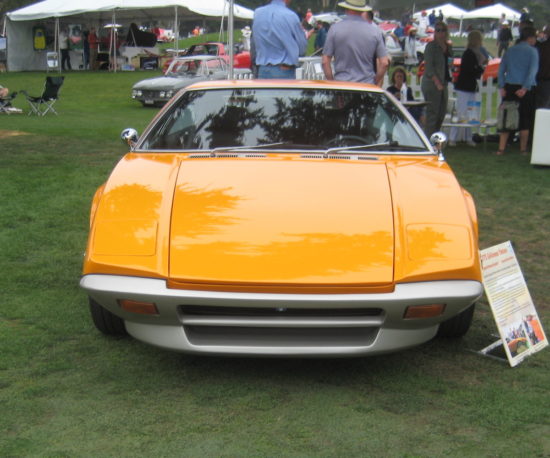
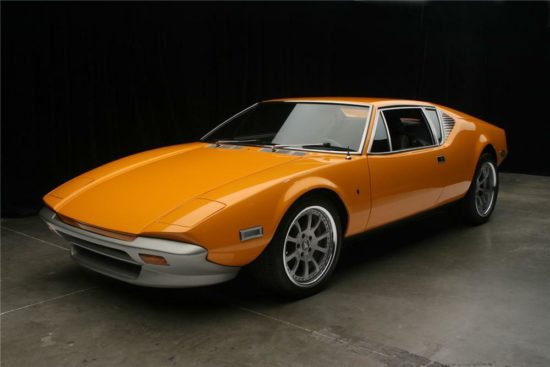
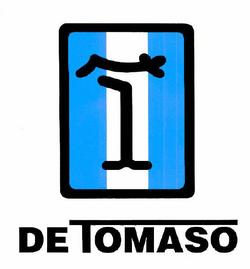
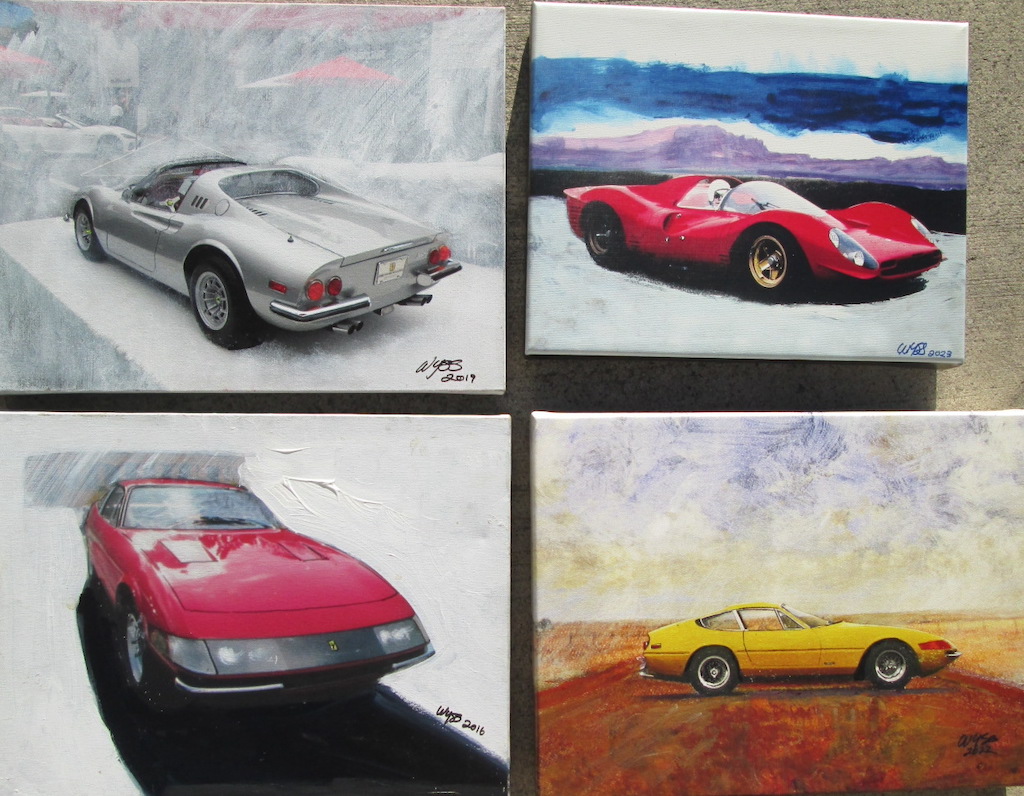

The U.S. GTS also had chrome tips that slipped over the OE Ansa tips and were held on with a set screw. All of the mechanical upgrades were excluded from the U.S. models–there were no performance related changes made. The last Pantera, a yellow Si model, was actually produced in the spring of 1995. I was at the factory and saw it being assembled for I believe a Swiss customer. On the same day, the Guara was being tested and I was given a ride in the blue test mule that had a BMW engine and dashboard (to accommodate the engine’s electricals). Fortunately, the museum was still intact.
You might consider doing a story on Tom Tjaarda, his life was interesting, son of a Dutch WWI fighter pilot who made it to the US and designed cars for Ford. The list of things he designed, from Ferraris to a Smith-Corona typewriter, is very impressive. Very personable and open, we miss having him at Pantera events in the U.S. since his death in 2017.
I reviewed a book about him here but I will do another another bio piece
Wallace,
I subscribe, must have missed the review. I have the book about him, I thought it was well done. Thank you for responding and for your articles.
Richard: write me your address if you want to talk about DeTomaso Racing Blue Bloods, a new book
richard@richardgreenblum.com
(512) 917-9315
6610 Lost Horizon Dr
Austin, TX 78759
whata load of bull!
automatic in a Pantera?
jan,
where did you read that?
Jan: Lighten up, bro. I haven’t heard of a Pantera with automatic but give us some slack for the handicapped.. I knew
a guy, farmer from Texas, who built two identical 427 Cobras with twin superchargers
because he had a lame left foot. Oh by the way he won LeMans years earlier.
His name: Carroll Shelby